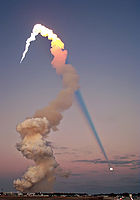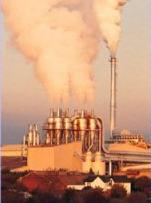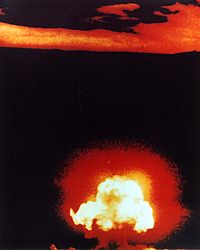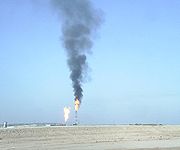
Plume (hydrodynamics)
Encyclopedia

Movement
Usually, as a plume moves away from its source, it widens because of entrainmentEntrainment (hydrodynamics)
Entrainment is the movement of one fluid by another.One fluid moving in another can push or pull the other along with it. Eductors or eductor-jet pumps are an excellent example. They are used onboard many ships to pump flooded out compartments in the event of an accident. Seawater is pumped to...
of the surrounding fluid at its edges. Plume shapes can be influenced by flow in the ambient fluid (for example, if local wind blowing in the same direction as the plume results in a co-flowing jet). This usually causes a plume which has initially been 'buoyancy-dominated' to become 'momentum-dominated' (this transition is usually predicted by a dimensionless number called the Richardson number).
Flow and detection
A further phenomenon of importance is whether a plume has laminar flowLaminar flow
Laminar flow, sometimes known as streamline flow, occurs when a fluid flows in parallel layers, with no disruption between the layers. At low velocities the fluid tends to flow without lateral mixing, and adjacent layers slide past one another like playing cards. There are no cross currents...
or turbulent flow. Usually there is a transition from laminar to turbulent as the plume moves away from its source. This phenomenon can be clearly seen in the rising column of smoke from a cigarette. When high accuracy is required, computational fluid dynamics
Computational fluid dynamics
Computational fluid dynamics, usually abbreviated as CFD, is a branch of fluid mechanics that uses numerical methods and algorithms to solve and analyze problems that involve fluid flows. Computers are used to perform the calculations required to simulate the interaction of liquids and gases with...
(CFD) can be employed to simulate plumes, but the results can be sensitive to the turbulence model chosen. CFD is often undertaken for rocket plumes, where condensed phase constituents can be present in addition to gaseous constituents. These types of simulations can become quite complex, including afterburning and thermal radiation
Thermal radiation
Thermal radiation is electromagnetic radiation generated by the thermal motion of charged particles in matter. All matter with a temperature greater than absolute zero emits thermal radiation....
, and (for example) ballistic missile
Ballistic missile
A ballistic missile is a missile that follows a sub-orbital ballistic flightpath with the objective of delivering one or more warheads to a predetermined target. The missile is only guided during the relatively brief initial powered phase of flight and its course is subsequently governed by the...
launches are often detected by sensing hot rocket plumes. Similarly, spacecraft managers are sometimes concerned with impingement of attitude control system
Attitude control system
In spaceflight, the attitude control system or attitude determination and control system of a spacecraft consists of equipment to measure, report and change the orientation of the vehicle.- Components :...
thruster plumes onto sensitive subsystems like solar arrays and star trackers.

Vortex
A vortex is a spinning, often turbulent,flow of fluid. Any spiral motion with closed streamlines is vortex flow. The motion of the fluid swirling rapidly around a center is called a vortex...
(smoke ring
Smoke ring
A smoke ring is a visible vortex ring formed by sudden release of smoke. It can be created by blowing smoke from the mouth, quickly lighting a cigarette lighter and putting it out or holding a burning incense stick or a cigarette vertically, pushing it with the burning side up and suddenly pulling...
).
Types
Pollutants released to the ground can work their way down into the groundwaterGroundwater
Groundwater is water located beneath the ground surface in soil pore spaces and in the fractures of rock formations. A unit of rock or an unconsolidated deposit is called an aquifer when it can yield a usable quantity of water. The depth at which soil pore spaces or fractures and voids in rock...
. The resulting body of polluted water within an aquifer
Aquifer
An aquifer is a wet underground layer of water-bearing permeable rock or unconsolidated materials from which groundwater can be usefully extracted using a water well. The study of water flow in aquifers and the characterization of aquifers is called hydrogeology...
is called a plume, with its migrating edges called plume fronts. Plumes are used to locate, map, and measure water pollution
Water pollution
Water pollution is the contamination of water bodies . Water pollution occurs when pollutants are discharged directly or indirectly into water bodies without adequate treatment to remove harmful compounds....
within the aquifer's total body of water, and plume fronts to determine directions and speed of the contamination's spreading in it.
Plumes are of considerable importance in the atmospheric dispersion modeling
Atmospheric dispersion modeling
Atmospheric dispersion modeling is the mathematical simulation of how air pollutants disperse in the ambient atmosphere. It is performed with computer programs that solve the mathematical equations and algorithms which simulate the pollutant dispersion...
of air pollution
Air pollution
Air pollution is the introduction of chemicals, particulate matter, or biological materials that cause harm or discomfort to humans or other living organisms, or cause damage to the natural environment or built environment, into the atmosphere....
. A classic work on the subject of air pollution plumes is that by Gary Briggs.
A thermal plume is one which is generated by gas rising above heat source. The gas rises because thermal expansion
Thermal expansion
Thermal expansion is the tendency of matter to change in volume in response to a change in temperature.When a substance is heated, its particles begin moving more and thus usually maintain a greater average separation. Materials which contract with increasing temperature are rare; this effect is...
makes warm gas less dense than the surrounding cooler gas.

Simple plume modelling
Quite simple modelling will enable many properties of fully developed, turbulent plumes to be investigated (see e.g.).- It is usually sufficient to assume that the pressure gradient is set by the gradient far from the plume (this approximation is similar to the usual Boussinesq approximationBoussinesq approximationIn fluid dynamics, the Boussinesq approximation is used in the field of buoyancy-driven flow . It states that density differences are sufficiently small to be neglected, except where they appear in terms multiplied by g, the acceleration due to gravity...
) - The distribution of density and velocity across the plume are modelled either with simple Gaussian distributions or else are taken as uniform across the plume (the so-called 'top hat' model).
- Mass entrainment velocity into the plume is given by a simple constant times the local velocity - this constant typically has a value of about 0.08 for vertical jets and 0.12 for vertical, buoyant plumes. For bent-over plumes, the entrainment coefficient is about 0.6.
- Conservation equations for mass flux (including entrainment) and momentum flux (allowing for buoyancy) then give sufficient information for many purposes.
For a simple rising plume these equations predict that the plume will widen at a constant half-angle of about 6 to 15 degrees.
A top-hat model of a circular plume entraining in a fluid of the same density
 is as follows:
is as follows:The Momentum M of the flow is conserved so that
-
 is constant
is constant
The mass flux J varies, due to entrainment at the edge of the plume, as
where k is an entrainment constant, r is the radius of the plume at distance x, and A is its cross-sectional area.
This shows that the mean velocity v falls inversely as the radius rises, and the plume grows at a constant angle dr/dx= k'

See also
- Atmospheric dispersion modelingAtmospheric dispersion modelingAtmospheric dispersion modeling is the mathematical simulation of how air pollutants disperse in the ambient atmosphere. It is performed with computer programs that solve the mathematical equations and algorithms which simulate the pollutant dispersion...
- Bibliography of atmospheric dispersion modeling
- Air pollution dispersion terminologyAir pollution dispersion terminologyAir pollution dispersion terminology includes the words and technical terms that have a special meaning to those who work in the field of air pollution dispersion modeling...


